PneumaCycle
Exploring pneumatic architecture and collective performance, PneumaCycle questions how large-scale events requiring loads of energy resources, could be powered by public participation. Could air captured by audience motion be transformed into the performance of kinetic architecture?
The development process consisted of intensive research in multiple areas including the design of a cycle pump system, testing of a variety of air-actuation systems, sensors and interfaces. The final outcome is an architectural proposal and a1:10 working model that invites the public to generate power that activates a soft robotic structure.
The proposal imagines a future for event design where audience members are fully immersed in the production of a collective performance powered by their own bodies.

Concept drawing
This project is separated into four phases:
Phase 1 (2020.3-2020.7 ) Research and Testing
Phase 2 (2020.8-2021.5) Design Studies
Phase 3 (2021.5-2021.11) Prototyping and Manufacturing
Phase 4 (2021.9-) Future Development
Phase 1 (2020.3-2020.7) includes research into large scale performing inflatables and their energy systems. The team creates cycle pump system to show the idea of human as an energy source for performance of machine and tests with different air systems.

Prototype details
The research went into a variety of possible ways in air actuated architecture spanning from architectural proposals, art installations, commercial products, street performance, theater performance to the robotics. The categories are placed according to the pouch’s type, the scale, the adaptation of functioning indoor or outdoor, the air driven system and the control system. The taxonomy help us to make decisions and settled working with the air pouch system.

The taxonomy of large scale inflatables







The advantage and disadvantage of air pouch system
Through research on air pouch systems with different scales, adaptations and their corresponding air driven systems and control systems, the team conducted experiments on high pressure and low pressure air driven systems respectively. After comparing the efficiency and the diversity of pouch shapes, the low pressure air pouch system was chosen for in-depth study.
According to the technologies in recent air design fields, to make inflatables with designed patterns, 3d printer is used to heat-seal relatively small scale ones. The material suitable for heat-seal is TPU laminated Nylon. The diamond shape in the double-layer heat-sealing process to control shapes after inflation is successful. Furthermore, to control a relatively large scale inflation, folding shapes and centripetal patterns is often applied. There is a specific sequential of inflation because of the relatively large scale and path of airflow. The team use collage technique to simulate the dynamic movements of the air pouches.
Phase 2 (2020.8-2021.5) are several design studies on different public venues such as urban open space, streets and sea, could be situated into events like theatre festivals, pop-up exhibitions and street performance. The studies also explore performance settings and their corresponding control systems for immersive inflatables.


Design study 1:Pedalling, designed by Yuting Chen


Design study 2:Machinery operation with pulleys and rigs, designed by Yuting Chen

Design study 3: Sea venue, designed by Ting-yun Wu

Design study 4: Indoor venue, designed by Ting-yun Wu
Phase 3 (2021.5-2021.11) consists of an exhibition version of the combination of the two systems. It is controlled by two people, showed as a 1:10 scale physical model.

1:10 scale exhibition version model
Among a bunch of failed attempts, here presents one of the working control systems which help the air pouch system inflate and deflate under controllable air pressure. Based on this control system, the air pouch system could scale up. Also, this combination of model encourages the audience taking control of air pressure and manually manipulating its behaviour.

Circuits diagram: Control system of solenoid valves and pressure sensors

Plan view of the control system, consist of Arduino controllers, PCB boards, jumper wires, solenoids, power adapters, etc.

The work flow of the system
Phase 4 (2021.9-) made an argument that PneumaCycle could serve the art festival in outdoor venues, invites the public to engage in interactive ways.

The proposal for future development

The proposal for future development

The plan view of future proposal
More working process shows here.
For more informations about the team, please visit:
https://www.yutingchen0402.com/
https://www.wutingyundesign.com/
Thank you Ruairi Glynn and Parker Heyl for their guidance throughout two years.
Reference:
Warren, J. (2017). Creating Worlds: How to make Immersive Theatre. Nick Hern Books Limited.
Glynn, R. (2019). The Irresistible Animacy of Lively Artefacts (Doctoral dissertation, UCL (University College London)).
Capeto, C. (2015). Dramaturgy as an enquiry on how interweave space, body and technology in performative interactive installations. In 21st International Symposium on Electronic Art (ISEA2015), Vancouver, Canada. Retrieved January (Vol. 5, p. 2016).
McKinney, Joslin, and Scott Palmer, eds. Scenography Expanded. London: Bloomsbury Publishing. Web. 10 May 2020. https://www.dramaonlinelibrary.com/theatre-crafts/ scenography-expanded-iid-184258/ba-9781474244428-0000149




